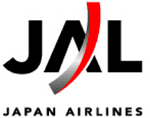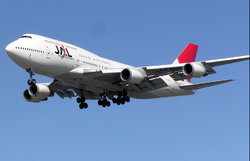Japan Airlines
|
|
Japan Airlines (Japanese: 日本航空 Nihon Kōkū, or JAL) is the largest airline in Asia.
The Japan Airlines Corporation (Japanese: 株式会社日本航空) operates two airline companies under the JAL brand. Japan Airlines International (Japanese: 株式会社日本航空インターナショナル) operates a vast international route network centered around its hub at Narita International Airport in Narita, Japan and Kansai International Airport in southern Osaka, Japan. Japan Airlines Domestic (Japanese: 株式会社日本航空ジャパン) is based at Tokyo International Airport in Tokyo and Osaka International Airport in Osaka, and connects Japan's major cities with jet flights, a market where it competes with All Nippon Airways. JAL also owns eight other airlines: Harlequin Air, Hokkaido Air System, JAL Express, JALWays, J-Air, Japan Air Commuter, Japan Asia Airways, and Japan Transocean Air.
Among other distinctions, JAL has the largest fleet of Boeing 747s in the world (approximately 76, at March 2005), and is the only Asian airline that flies to Mexico City.
| Contents |
Code Data
History
The former Japan Air Lines was established in 1951, with the government of Japan recognizing the need for a reliable air transportation system to help Japan grow in the aftermath of World War II. Its first aircraft, a DC-3 named "Kinsei", was leased from Philippine Airlines.
In 1952, a Martin 2-0-2 of Japan Air Lines crashed, killing all 37 on board.
In 1953, the new Japan Airlines, which was owned by Japanese government, was established and the former company was dissolved.
Japan Airlines, in addition to the 2-0-2's, used DC-3, DC-4, DC-6 and DC-7 during the 1950s. Towards the end of that decade, it started its first international service, to San Francisco.
In 1960, Japan Airlines bought their first jet, a DC-8. Soon after, they decided to re-equip their airline, using jet airplanes only. That decade, many new international destinations were established.
In the 1970s they bought the Boeing 747, the Boeing 727 and the McDonnell Douglas DC-10 to accommodate the ever growing list of international routes, both to its Asian neighbors, and around the world.
800pix.jal.b747-400.ja8079.jpg
In the 1980s Japan Airlines performed special flights for the Crown Prince of Japan and the Princess, Pope John Paul II, and various Japanese prime ministers. During that decade they also began to be more promotionally aware, with plane models and other promotional items being produced in quantity. It also bought new Boeing 767 jets and retired the DC-8's and 727's.
On August 12, 1985, Japan Airlines flight 123, a 747 bound for Osaka International Airport, Itami/Toyonaka, lost control and crashed into a mountain after takeoff from Tokyo International Airport, Ota, Tokyo; it is the worst single-aircraft disaster in history; 520 out of 524 people on board died(the number excludes an unborn baby who died with a pregnant mother).
In 1987, Japan Airlines Co,Ltd was completely privatised.
Japan Airlines began the 1990s with flights to help evacuate Japanese citizens from Iraq before the start of the Gulf War. In 1992, Japan Air Charters was established, and in 1997, an agreement with The Walt Disney Company was announced, making Japan Airlines the official airline of Disney Tokyo. That year also, JALExpress had been established, with Boeing 737 aircraft. Also in 1997, the airline had to fly the Japanese prime minister to Peru to help negotiate in the Tupac Amaru kidnapping case. Japan Airlines acquired Boeing 777's during that decade, and it was named the official airline of the Sydney Olympic Games.
Jal.cargo.b747.arp.jpg
Japanese airlines had kept the Big 3 (Japan Airlines, All Nippon Airways and JAS) structure for many years. But in 2001, Japan Air System (JAS) and Japan Airlines (JAL), the largest of the Big 3, agreed to merge.
On October 2, 2002, JAS and JAL established a new holding company which was called Japan Airlines System (日本航空システム) and they were reborn as the new Japan Airlines (JAL) group. Airplane liveries were changed to match the design of the new JAL group. At that time, the new JAL group was the sixth largest in the world by passengers carried and the third largest measured by revenue.
On April 1, 2004, Japan Airlines (old JAL) changed its name to Japan Airlines International and Japan Air System (JAS) changed its name to Japan Airlines Domestic. At the same time, all JAS flight codes, check-in desks and plane were unified into JAL.
On June 26, 2004, Japan Airlines System was renamed to Japan Airlines Corporation to make the most of the JAL brand.
JALUX Inc., established 1962, is JAL's catering company which also does a variety of work for the company including the "De sky" line of snack foods, supplying JAL's 'Blue Sky' and 'JAL-DFS' shops, Aircraft fuel components, cabin services and In-flight duty-free. JALUX merged with JAS TRADING on January 2004 to form one complete company.
Japan Airlines is one of the most widely known companies by model aeroplane collectors, their planes being produced in mass quantities by Schabak, Wooster, Flight Miniatures, Long Prosper, Dragon Wings, etc., etc.
Onboard Entertainment
JAL and JAA are known for their onboard entertainment system called MAGIC. The system is updated by JAL Entertainment Network (JEN) and features credit card phone, multiple movies, destination guides with imigration card filling instructions, active airplane stats, games and more. There are three generations of the MAGIC system: MAGIC-I, MAGIC-II, and MAGIC-III. The latest MAGIC-III system which is installed in Boeing 767 and Boeing 777 aircrafts, provides Audio/Video On Demand (AVOD) entertainment to the passengers. Recently, MAGIC systems have had the duty-free shopping catalouge added , including flight crew recommendations and a video of specials avalible on your flight.
Fleet
The Japan Airlines fleet consists of the following aircraft (at March 2005):
- 8 Boeing 737-400 (JAL Express/JEX)
- 3 Boeing 747-100
- 15 Boeing 747-200
- 11 Boeing 747-300
- 42 Boeing 747-400
- 2 Boeing 747-400F
- 3 Boeing 767-200
- 33 Boeing 767-300 (further 2 on order)
- 15 Boeing 777-200 (further 3 on order)
- 9 Boeing 777-300 (further 2 on order)
- 8 McDonnell Douglas DC-10
- 18 McDonnell Douglas MD-81
- 8 McDonnell Douglas MD-87
- 16 McDonnell Douglas MD-90
- 28 Airbus A300
Aircraft disposed of include 8 Boeing 737-400, 8 Boeing 747-100, 6 Boeing 747SR (one now being used as a NASA Shuttle Carrier Aircraft), 19 Boeing 747-200, 5 Boeing 747-300 and 10 McDonnell Douglas MD-11 aircraft.
In December 2004 Japan Airlines announced the selection of the Boeing 787 for its medium-size aircraft fleet. It is seeking 30 aircraft, with options on 20 more. Delivery is expected to start from 2008 and the aircraft will be used on domestic and international routes (ref: Airliner World, March 2005).
The Japan Airlines remains as the largest Boeing 747 operator in the world since 1984 to update..
Livery
JAL is known for adopting special liveries for individual aircraft. One 747, registration JA8908, carries an Adidas soccer livery. Another 747, registration JA8907, is the dream skyward baseball plane. The airline's Boeing 767-300, registration JA8253, is the Expo 2005 airplane. JALways' fleet includes some colourful Boeing 747 and DC-10 aircraft with "Reso'Cha" titles. These aircraft are used on charter flights to holiday destinations in the Pacific, such as Hawaii. Reso'Cha is a marketing abbreviation for Resort Charter.
Destinations
See article: Japan Airlines destinations
External links
- Airline website (http://www.jal.co.jp/en/) (Japanese (http://www.jal.co.jp/))
- Corporate website (http://www.jal.jp/en/) (Japanese (http://www.jal.jp/))
- Japan Airlines Fleet Detail (http://www.planemad.net/Airline/JP/Japan_Airlines_(JL_JAL)/Fleet.htm?show=all)
- Japan Airlines Passenger Opinions (http://www.airlinequality.com/Forum/jal.htm)
|
Lists of Aircraft | Aircraft manufacturers | Aircraft engines | Aircraft engine manufacturers Airports | Airlines | Air forces | Aircraft weapons | Missiles | Timeline of aviation |


